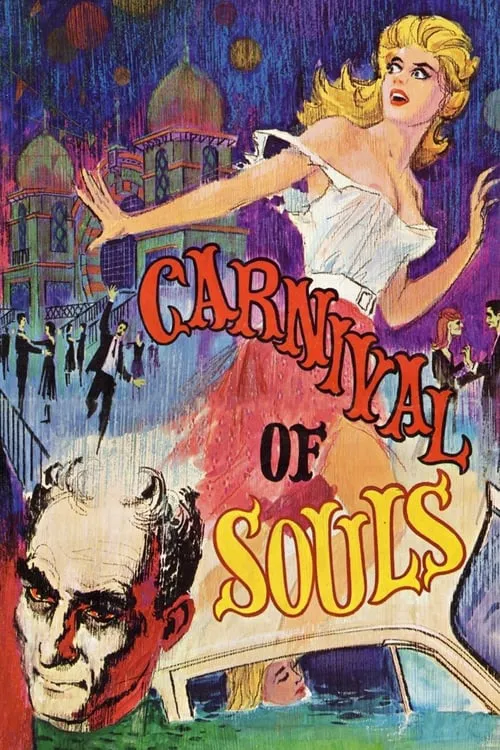Carnival of Souls

Plot
Carnival of Souls, a 1962 American psychological horror film directed by Herk Harvey, is a deeply unsettling and thought-provoking exploration of the supernatural and the psychological state of its protagonist, Mary Henry. From the opening frames, it's clear that this is a film that eschews traditional horror conventions in favor of a more atmospheric and introspective approach, one that invites the viewer to ponder the mysterious events that unfold. The film begins with a sequence of images that are both jarring and beautiful: a car wreck, a fatal accident that leaves a trail of destruction and a sense of chaos in its wake. We're introduced to Mary Henry, played by Candace Hilligoss, a young woman who emerges from the wreckage seemingly unscathed, only to be left reeling from the trauma of what's occurred. The sequence is shot with a raw, documentary-style honesty, which only serves to heighten the sense of shock and disorientation. As Mary attempts to come to terms with her newfound existence, she moves to Utah, a seemingly idyllic location where she takes up a new life as a church organist. On the surface, all appears to be well: Mary has a steady job, a quiet life, and a sense of purpose. Yet, beneath the surface, she's struggling to shake off the lingering effects of the accident. It's here that the film's tone begins to shift, as Mary's visions of a fiendish man begin to manifest, casting a dark and foreboding shadow over her daily existence. The figure that haunts Mary's dreams, played by a hauntingly effective Frances Feist, is a spectral presence that seems to embody the horrors of her past. His face is a twisted, macabre countenance, a visage that seems to leer out at us from the shadows, taunting Mary with the darkness that she's tried to escape. It's a masterstroke of cinematic design, as the figure's appearance is always lurking just out of focus, a sense of presence that's both unnerving and mesmerizing. As the visions intensify, Mary finds herself drawn to the deserted carnival on the outskirts of town, a location that's both alluring and repellent. The carnival, with its rusty Ferris wheel and peeling paint, seems to be a manifestation of Mary's own troubled psyche, a symbol of the darker forces that she's tried to keep at bay. It's a place where the boundaries between reality and the supernatural begin to blur, where the rational and the irrational collide in a swirl of color and sound. Here, Harvey's direction is both innovative and influential. He uses a range of techniques to create an atmosphere of creeping unease, from low-angle shots that make the viewer feel trapped and claustrophobic to point-of-view sequences that put us in Mary's shoes. The visual style is often described as "low-budget," but what this belies is Harvey's skill in using limited resources to create a sense of depth and texture that's both haunting and beautiful. At the same time, the film's use of atmospheric sound design is crucial to its effect. Sound effects are often used to create a sense of tension and unease, from the eerie howls of the wind to the distant chimes of the carnival music. It's a masterclass in building tension through the use of sound alone, as the viewer is left to piece together the events that unfold from the fragments of audio and visual clues. As the film builds towards its conclusion, we're left with a series of questions that linger long after the credits have rolled. What is the nature of Mary's visions? Is the fiendish man a product of her own guilt-ridden psyche, or is he a genuine supernatural presence? And what lies at the heart of the carnival, a place that's both a symbol of the dark forces that Mary's trying to confront and a manifestation of her own inner turmoil? The film's ending, which is both ambiguous and unsettling, suggests that Mary's journey towards self-discovery is far from over. As she disappears into the labyrinthine corridors of the carnival, the viewer is left with a sense of unease and uncertainty, a feeling that the true horrors that Mary's confronted are only just beginning to reveal themselves. In its use of mystery and ambiguity, Carnival of Souls is a film that invites the viewer to fill in the gaps, to piece together the fragmented narrative and draw their own conclusions about the events that unfold. Ultimately, Carnival of Souls is a film that defies easy interpretation, a work of cinematic art that's both deeply unsettling and profoundly thought-provoking. It's a film that challenges the viewer to confront the darker corners of their own psyche, to peer into the abyss of the unknown and to confront the horrors that lurk within. As a work of art, it's a landmark of American cinema, a testament to the power of the human imagination to create worlds that are both beautiful and terrifying.
Reviews
Recommendations




